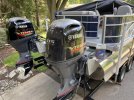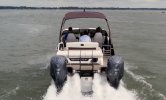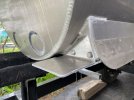DVW
Well-Known Member
- Messages
- 297
- Reaction score
- 546
A outboard motor is bolted on with only four bolts. I found there is more to the task than four bolts-much much more. It starts with more buoyancy to handle the weight of the extra motor. I choose to replace the two tubes with jumbo tubes rather than having the drag associated with three tubes. A two key switch panel replaced the original single switch. The single control lever got replaced by a dual lever control with new cables. Trim control got moved to the steering wheel because my dual levers lacked switches. Extra gauges went with the extra motor. In my case I cut or enlarged 8 extra holes in the console. A console wire harness had to be created to interface with an additional engine harness. My project demanded a new fuel tank in a new spot. Steering the extra motor required hydraulic steering with the steer cylinders plumbed in series with each other. I choose to link the steer cylinders hydraulically. This choice required a realignment valve. Everything had to be plumbed with many hoses. The choice of props is still being refined. In the end it was much more than four bolts.





